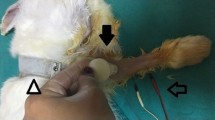Abstract
The experiments reported here demonstrate that the mechanical sensitivity of peripheral nerve fibres typically seen after injury can be induced without overtly injuring the nerve, but by simply applying colchicine topically to the nerve. In cats anaesthetised with pentobarbitone sodium, the medial gastrocnemius nerve was exposed and 10 mM colchicine applied topically for 15 min. The animals recovered from the operation normally and showed no subsequent motor deficit. Six days later animals were re-anaesthetised, a laminectomy carried out and responses recorded in single afferents at the level of the dorsal root. It was found that many afferents, particularly those with conduction velocities in the group II–III range, had become sensitive to local mechanical stimulation of the nerve in the region treated with colchicine and showed slowly adapting responses to stretch of the nerve. Many of the smaller fibres exhibited spontaneous activity. Mechanically sensitive afferents exhibited impulse conduction blocks at the colchicine-treated site. Some afferents, which appeared to conduct impulses normally through the treated region, were associated with muscle receptors having normal response properties. However, other muscle receptors were clearly abnormal and were insensitive to muscle stretch or contraction or exhibited only phasic responses. When the nerve was cut proximal to the colchicine-treated site, some, but not all, spontaneous activity was abolished. It was subsequently shown using a collision technique that the activity in some axons had its origin in the cell body in the dorsal root ganglion. In one experiment, it was shown that after nerve section proximal to the colchicine-treated region three of five axons switched their activity from a peripheral to a central origin. It is postulated that colchicine disrupts fast axonal transport of mechanically sensitive or voltage-sensitive ion channels, from the cell body to the peripheral terminals of the axons, leading to an accumulation of these channels at the treated site. This induces mechanical sensitivity and spontaneous activity. It is postulated that interruption of a retrogradely transported signal induces the spontaneous activity in the cell body. These experiments suggest that an important influence is exerted by the cell body on the peripheral terminals of mechanoreceptors to confer on them their normal response properties.
Similar content being viewed by others
Author information
Authors and Affiliations
Additional information
Received: 9 June 1997 / Accepted: 7 October 1997
Rights and permissions
About this article
Cite this article
Proske, U., Luff, A. Mechanical sensitivity of muscle afferents in a nerve treated with colchicine. Exp Brain Res 119, 391–398 (1998). https://doi.org/10.1007/s002210050354
Issue Date:
DOI: https://doi.org/10.1007/s002210050354




